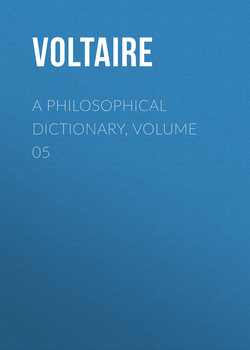Читать книгу A Philosophical Dictionary, Volume 05 - Voltaire, Вольтер - Страница 13
FIGURED – FIGURATIVE
ОглавлениеWe say, a truth "figured" by a fable, by a parable; the church "figured" by the young spouse in Solomon's Song; ancient Rome "figured" by Babylon. A figurative style is constituted by metaphorical expressions, figuring the things spoken of – and disfiguring them when the metaphors are not correct.
Ardent imagination, passion, desire – frequently deceived – produce the figurative style. We do not admit it into history, for too many metaphors are hurtful, not only to perspicuity, but also to truth, by saying more or less than the thing itself.
In didactic works, this style should be rejected. It is much more out of place in a sermon than in a funeral oration, because the sermon is a piece of instruction in which the truth is to be announced; while the funeral oration is a declaration in which it is to be exaggerated.
The poetry of enthusiasm, as the epopee and the ode, is that to which this style is best adapted. It is less admissible in tragedy, where the dialogue should be natural as well as elevated; and still less in comedy, where the style must be more simple.
The limits to be set to the figurative style, in each kind, are determined by taste. Baltasar Gracian says, that "our thoughts depart from the vast shores of memory, embark on the sea of imagination, arrive in the harbor of intelligence, and are entered at the custom house of the understanding."
This is precisely the style of Harlequin. He says to his master, "The ball of your commands has rebounded from the racquet of my obedience." Must it not be owned that such is frequently that oriental style which people try to admire? Another fault of the figurative style is the accumulating of incoherent figures. A poet, speaking of some philosophers, has called them:
D'ambitieux pygmées
Qui sur leurs pieds vainement redressés
Et sur des monts d'argumens entassés
De jour en jour superbes Encelades,
Vont redoublant leurs folles escalades.
When philosophers are to be written against, it should be done better. How do ambitious pygmies, reared on their hind legs on mountains of arguments, continue escalades? What a false and ridiculous image! What elaborate dulness!
In an allegory by the same author, entitled the "Liturgy of Cytherea," we find these lines:
De toutes parts, autour de l'inconnue,
Ils vont tomber comme grêle menue,
Moissons des cœurs sur la terre jonchés,
Et des Dieux même à son char attachés.
De par Venus nous venons cette affaire
Si s'en retourne aux cieux dans son sérail,
En ruminant comment il pourra faire
Pour ramener la brebis au bercail.
Here we have harvests of hearts thrown on the ground like small hail; and among these hearts palpitating on the ground, are gods bound to the car of the unknown; while love, sent by Venus, ruminates in his seraglio in heaven, what he shall do to bring back to the fold this lost mutton surrounded by scattered hearts. All this forms a figure at once so false, so puerile, and so incoherent – so disgusting, so extravagant, so stupidly expressed, that we are astonished that a man, who made good verses of another kind, and was not devoid of taste, could write anything so miserably bad.
Figures, metaphors, are not necessary in an allegory; what has been invented with imagination may be told with simplicity. Plato has more allegories than figures; he often expresses them elegantly and without ostentation.
Nearly all the maxims of the ancient orientals and of the Greeks were in the figurative style. All those sentences are metaphors, or short allegories; and in them the figurative style has great effect in rousing the imagination and impressing the memory.
We know that Pythagoras said, "In the tempest adore the echo," that is, during civil broils retire to the country; and "Stir not the fire with the sword," meaning, do not irritate minds already inflamed. In every language, there are many common proverbs which are in the figurative style.
